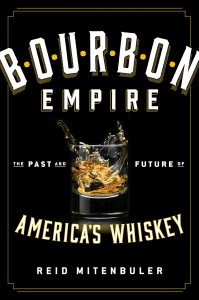 I realize that movie Westerns are no longer the cultural touchstone they were for my generation, but I’m sure many of you have no trouble remembering a movie scene in which a cowboy walks into a saloon, orders a whiskey and the barkeep pours him one from a clear glass quart-size bottle. Maybe the cowboy even says “I’ll take the bottle” and heads for a table. Sorry, but it probably didn’t happen that way. Like so many other historical details, the makers of Westerns probably got that one wrong, or so implies Reid Mitenbuler in his lucid book Bourbon Empire.
I realize that movie Westerns are no longer the cultural touchstone they were for my generation, but I’m sure many of you have no trouble remembering a movie scene in which a cowboy walks into a saloon, orders a whiskey and the barkeep pours him one from a clear glass quart-size bottle. Maybe the cowboy even says “I’ll take the bottle” and heads for a table. Sorry, but it probably didn’t happen that way. Like so many other historical details, the makers of Westerns probably got that one wrong, or so implies Reid Mitenbuler in his lucid book Bourbon Empire.
Mitenbuler is a journalist and whiskey expert who has written about whiskey and “drinking culture” for The Atlantic, Slate, and Saveur, and writes a “Drinking in History” column for Serious Eats. This is his first book, but it doesn’t show. It’s seriously well written, well organized, thorough, readable and entertaining. It took me a little longer to get through than it should’ve, because after a while of reading about bourbon, I’d find myself thinking, “That sounds good,” and have myself a tipple. Which isn’t all that conducive to serious reading.
But I learned a lot from this book. Mitenbuler has done his research – both historical and apparently copious amounts of tasting. Which makes his clear-headed approach to the somewhat fabulous topic of bourbon all the more impressive. The bourbon business has, apparently from its beginnings back when the U.S.A. was still a collection of colonies, been rife with mythology, skullduggery and outright fabrication. The mythification of bourbon continued through its first golden age when its manufacture became industrialized, was renewed as it made is comeback following the disastrous Prohibition era, and is once again in full swing as bourbon enjoys a renaissance in the 21st Century.
Want to learn some interesting history that most of the country has forgotten? Well, for one thing, back to that cowboy in the bar. Glass bottles were too rare and expensive for mass use until the late 1870s, Mitenbuler points out. Not only that, but until the 20th Century, most whiskey in America was shipped in barrels and then bottled by middlemen (if at all). If it was served in a saloon, it probably wasn’t bottled at all, but served out of a pitcher or other vessel. Or how about this:
Between the Civil War and Prohibition, Peoria (Illinois) made more spirits than any other place in the United States. The city was the largest purchaser of corn in the world and produced 185,000 gallons of spirits per day, contributing more alcohol-related taxes to the government than any other place in the country (next in line were Chicago and Cincinnati, the other two biggest distilling centers). Peoria’s former primacy, however, was quietly forgotten after the whiskey industry later consolidated in Kentucky and Tennessee, the winners that ultimately got to write history.
Mitenbuler details how whiskey became the preferred drink in the young America, how and why it flourished in the mid- to late-19th Century, how it was involved in the rise of consumer research and advertising in the early 20th, how its makers failed to anticipate Prohibition and how it was resurrected afterward, how it became a patriotic drink during World War II and emblematic of the new American hegemony afterward, how it fell to vodka in the ’60s and ’70s, and was again resurrected beginning in the late ’90s with the rise of Maker’s Mark (which, not surprisingly, was my entree into bourbon). Along the way he discusses (and usually busts) myths at every turn, usually with facts and generally with logic and a lot of personal experience on his side.
But you shouldn’t take my word for it. If you enjoy reading about food and drink (and you wouldn’t be here if you didn’t), or enjoy well-written popular history on any topic, you’ll like Bourbon Empire. Even if you’re not a bourbon fan – but I bet you’ll be tempted to give it a try if you read this book. There’s much more about it on the Bourbon Empire blog.
Viking, 2015
